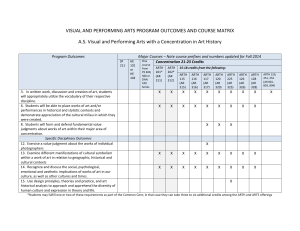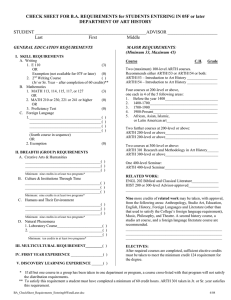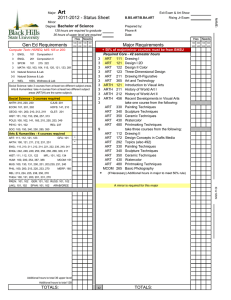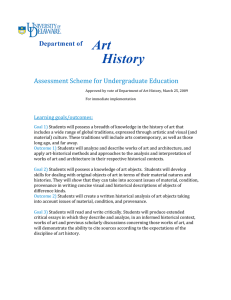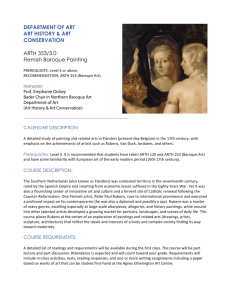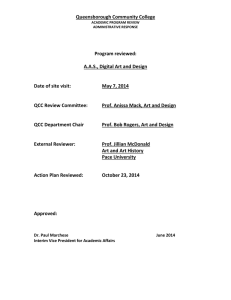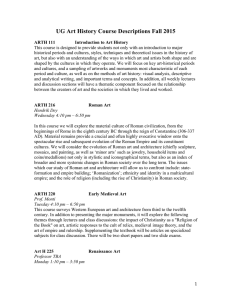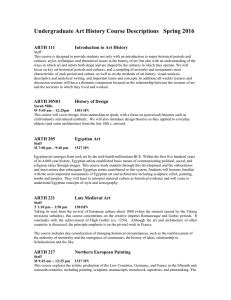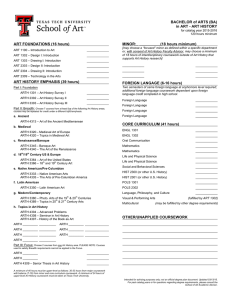PROGRAM OUTCOMES AND COURSE MATRIX
advertisement
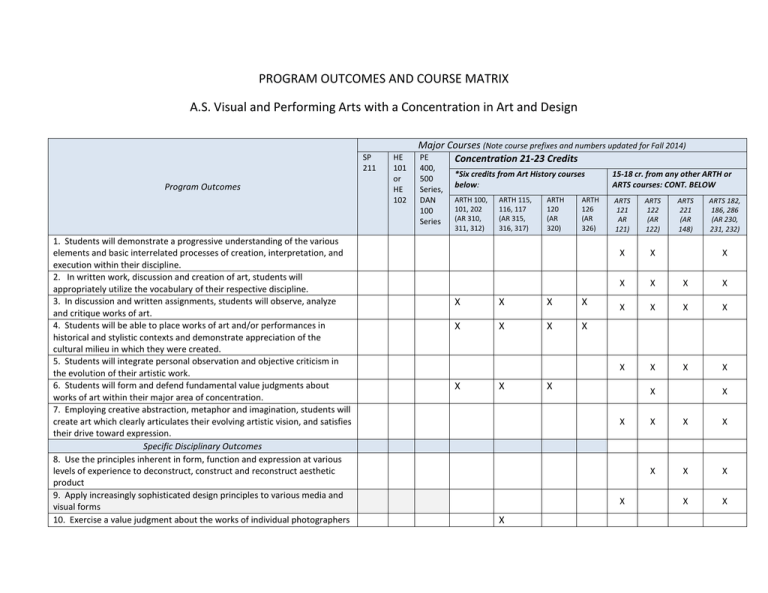
PROGRAM OUTCOMES AND COURSE MATRIX A.S. Visual and Performing Arts with a Concentration in Art and Design SP 211 Program Outcomes 1. Students will demonstrate a progressive understanding of the various elements and basic interrelated processes of creation, interpretation, and execution within their discipline. 2. In written work, discussion and creation of art, students will appropriately utilize the vocabulary of their respective discipline. 3. In discussion and written assignments, students will observe, analyze and critique works of art. 4. Students will be able to place works of art and/or performances in historical and stylistic contexts and demonstrate appreciation of the cultural milieu in which they were created. 5. Students will integrate personal observation and objective criticism in the evolution of their artistic work. 6. Students will form and defend fundamental value judgments about works of art within their major area of concentration. 7. Employing creative abstraction, metaphor and imagination, students will create art which clearly articulates their evolving artistic vision, and satisfies their drive toward expression. Specific Disciplinary Outcomes 8. Use the principles inherent in form, function and expression at various levels of experience to deconstruct, construct and reconstruct aesthetic product 9. Apply increasingly sophisticated design principles to various media and visual forms 10. Exercise a value judgment about the works of individual photographers HE 101 or HE 102 Major Courses (Note course prefixes and numbers updated for Fall 2014) PE Concentration 21-23 Credits 400, 500 Series, DAN 100 Series *Six credits from Art History courses below: 15-18 cr. from any other ARTH or ARTS courses: CONT. BELOW ARTH 100, 101, 202 (AR 310, 311, 312) ARTS 121 AR 121) ARTS 122 (AR 122) X X X X X X X X X X X X X X ARTH 115, 116, 117 (AR 315, 316, 317) ARTH 120 (AR 320) ARTH 126 (AR 326) X X X X X X X X X X X X ARTS 182, 186, 286 (AR 230, 231, 232) X X X X ARTS 221 (AR 148) X X X X X X X X X 11. Examine different manifestations of cultural symbolism within a work of art in relation to geographic, historical and cultural contexts 12. Recognize and discuss the social, psychological, emotional and aesthetic implications of works of art in our culture, as well as other cultures and times. 13. Use design principles, theories and practice, and art historical analysis to approach and apprehend the diversity of human culture and expression in theory and life. X X X X X X X X X X X X X X X *Students may fulfill one or two of these requirements as part of the Common Core; in that case they can take three to six additional credits among the ARTH and ARTS offerings. Concentration (see above) and 15-18 credits from any other ARTH or ARTS courses: CONCENTRATION CONTINUED: Program Outcomes 1. Students will demonstrate a progressive understanding of the various elements and basic interrelated processes of creation, interpretation, and execution within their discipline. 2. In written work, discussion and creation of art, students will appropriately utilize the vocabulary of their respective discipline. 3. In discussion and written assignments, students will observe, analyze and critique works of art. 4. Students will be able to place works of art and/or performances in historical and stylistic contexts and demonstrate appreciation of the cultural milieu in which they were created. 5. Students will integrate personal observation and objective criticism in the evolution of their artistic work. 6. Students will form and defend fundamental value judgments about works of art within their major area of concentration. 7. Employing creative abstraction, metaphor and imagination, students will create art which clearly articulates their evolving artistic vision, and satisfies their drive toward expression. Specific Disciplinary Outcomes 8. Use the principles inherent in form, function and expression at various levels of experience to deconstruct, construct and reconstruct aesthetic product ARTS 262, 263, 130,131, 132(AR-262, 263, 271, 272, 280) ARTS 141, 242, 343, 344 (AR 461, 462, 463, 464) ARTS 345 (AR 465) ARTS 346, 348 (AR 466, 468) ARTS 349 (AR 469) ARTS 291, 243 (AR 473, 474) ARTS 271, 272 (AR 510, 511) X X X X X X X X X X X X X X X X X X X X X X X X X X ARTS 151 (AR 251) ARTS 252, 253 (AR 252, 253) X X X X ARTS 161 (AR 261) X X X X X X X X X X X X X X X X X X X X X X X X X X X X X X X X X X X X X X X X X 9. Apply increasingly sophisticated design principles to various media and visual forms 10. Exercise a value judgment about the works of individual photographers 11. Examine different manifestations of cultural symbolism within a work of art in relation to geographic, historical and cultural contexts 12. Recognize and discuss the social, psychological, emotional and aesthetic implications of works of art in our culture, as well as other cultures and times. 13. Use design principles, theories and practice, and art historical analysis to approach and apprehend the diversity of human culture and expression in theory and life. X X X X X X X X X X X X X X X
